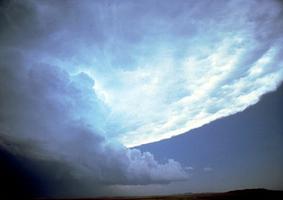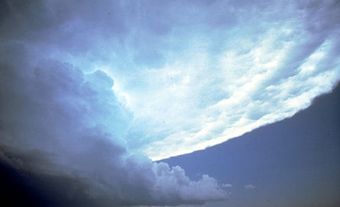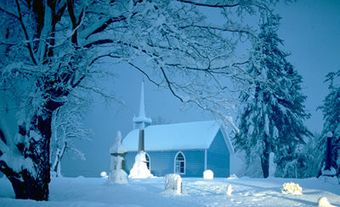Weather Forecasting
Weather forecasting attempts to predict the air temperature, humidity, wind speed and direction, precipitation, clouds, etc, that will occur at a given place or region at a particular time in the future. The atmosphere may be seen as a massive air machine which moves heat and moisture from place to place. Weather is a product of this machine. The workings of the atmosphere follow physical laws, ie, the laws of thermodynamics, motion, conservation of mass and energy, etc, which are very complex to apply (see physics). Since the Earth is almost spherical and spins on its own axis, the laws of motion cannot be described in simple terms. Some deviations from spherical shape, especially mountains and mountain ranges, create still more problems. In addition, most solar energy reaches the Earth in a band near the equator; the atmosphere and the oceans play a major role in distributing this excessive heat northward and southward, and this process further affects the various physical laws. As well, oceans have a different effect on the bottom part of the atmosphere than land does; and forests, lakes, plains, tundra, cities, etc, all have their own special effects on the atmosphere.
Most modern meteorologists attempt to cope with physical processes by expressing them mathematically, ie, by creating mathematical models of the atmosphere. Powerful computers are then used to solve problems. As computers become more powerful, the models can be made more complex and, often, more accurate. During the 1960s and 1970s, improved atmospheric models permitted useful forecasts projecting much further into the future than had been possible before; by 1980, forecasts, now called outlooks, extended 5 days into the future. Meteorologists are experimenting with equipment that will predict 10 to 14 days ahead, but it is not reliable enough for public use. Weather forecasting usually involves the following stages: observation of what is now happening at many places; analysis of the observations to create a comprehensive picture of what is now happening at various places in the atmosphere; projection of this picture into the future (prognosis); interpretation of that future picture to determine the temperature, humidity, wind, precipitation, etc, to be expected at the time represented by that picture.
Meteorologists who are more interested in a shorter time range (1-2 days) often bypass the mathematical model and use their knowledge of how one weather event follows another. For laymen, these types of observations are often the basis of much weather lore relating the appearance of the sky, the timing of precipitation, the recent history of the wind or the trend in pressure to predictions of what will happen next. Others observe animal behaviour or consider how people are affected (eg, painful joints, migraine headaches) to make their often correct predictions.
Severe local storms (eg, heavy showers, damaging windstorms, thunderstorms with hail, tornadoes) are of great interest, but because of their small size (often occurring between weather stations) and very short life cycles (usually tens of minutes from birth to death) they are very challenging for meteorologists to predict. Severe weather forecasters (meteorologists specially trained to forecast severe weather) are able to forecast relatively large areas that will be at risk during the next 6 to 12 hours. However, as storms develop, observations by Radar, weather satellites, lightning detectors, and reports from storm spotters are usually the only effective approach to detecting and predicting severe storm development, strength and motion.
National or continental boundaries are irrelevant to weather forecasting. This fact has made Meteorology a truly international science. The World Meteorological Organization (WMO), part of the United Nations structure, co-ordinates meteorological activities throughout the world. One of the organization's main programs, the World Weather Watch (WWW), attempts to provide the information analysis and exchange required by all national weather services to create weather forecasts. The principal elements of WWW are the Global Observing System, which provides the weather observations required for forecasting; the Global Telecommunications System, which makes the observations available to all countries needing them for weather forecasting; and the Global Data Processing System, which analyses the observations and carries out the prognosis function on behalf of countries lacking these capabilities. All countries benefit from the elements of the WWW; without it Canadian meteorologists could not be reasonably sure that they would get the weather observations required for forecasting, or that weather observations made in Canada would reach other countries needing them.
In Canada weather forecasting is carried out in the same way as in other scientifically advanced countries. Weather observations from all around the Earth's surface, from balloons released at many locations around the globe, and from satellites, radar, aircraft and ships are transmitted freely to all countries over the Global Telecommunications System. These data are analysed in the Canadian Meteorological Centre in Montréal to create a mathematical picture of the present condition of the atmosphere over the Northern Hemisphere. This picture is provided to Canadian meteorologists in the form of a series of weather maps for the surface and for various higher levels in the atmosphere. (Before 1990 the Canadian model may well cover the whole globe, since what happens in the Southern Hemisphere has an effect over Canada beyond the fourth or fifth day.) Next, the mathematical model is run in a computer in a series of short time steps, some as brief as 6 minutes. New series of charts are provided to meteorologists for specific intervals out to the end of the model run. The results of the model are incorporated by meteorologists with other weather data and then translated into weather forecasts. There is a great deal of research under way into using the model to give a direct prediction of the various elements of the weather; but, until that research bears fruit, weather forecasts will continue to be made by forecasters. Many aspects of the forecast are not done well automatically, largely because it is not yet possible to create mathematical models that are as complex as the atmosphere itself.

 Share on Facebook
Share on Facebook Share on X
Share on X Share by Email
Share by Email Share on Google Classroom
Share on Google Classroom




